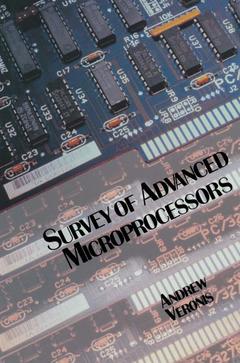Survey of Advanced Microprocessors, Softcover reprint of the original 1st ed. 1991
Langue : Anglais
Auteur : Veronis Andrew M.

Microprocessors have come a long way since their conception. They have become formidable processing tools, and we encounter them in almost every part of our daily activities, from the kitchen with its microwave oven to the cockpit of a sophisticated aircraft. The purposes of this book are to "walk through" the current microprocessor technology and briefly to describe some of the most advanced microprocessors available. The book is a survey of ad vanced microprocessors, aimed particularly at the engineering manager rather than the design engineer. Chapter One outlines the history of microprocessors and describes some terminology used in computer architecture. Chapter Two discusses advanced computer concepts, such as data and data types, addressing modes, pipe lining, and cache memory. Chapter Three .describes new computer architectures, such as reduced-instruction-set computers (RISes) and very-long-instruc tion-word computers. RISC architecture has become very popular among designers. Chapter Four discusses an architecture, data-flow, which is a departure from the conventional von Neumann architecture. NEC has applied the dataflow architecture on the design of a very sophis ticated image processing chip, the NEC PD7281. Chapters Five and Six are case studies, describing the Am29000 and the Transputer, respectively. Chapter Seven describes microprocessors specifically designed for digital signal processing. Chapter Eight discusses micromultiprocessing and describes the various topologies currently used.
1. Introduction.- The History of Microprocessors.- Advanced Microprocessors.- Terminology.- Granularity.- Summary.- Notes.- 2. Advanced Computer Concepts.- General Comments.- Data and Data Types.- Semantic Gap.- Instruction Sets.- Addressing Modes.- Pipelining.- Memory Management.- Summary.- Notes.- 3. Reduced-Instruction-Set, Writable-Instruction-Set, and Very-Long-Instruction-Word Computers.- Reduced-Instruction-Set Computer (RISC).- Writable-Instruction-Set Computer (WISC).- Very-Long-Instruction-Word Computer (VLIW).- Summary.- Notes.- 4. Data-Flow Computers.- Concept Behind Data Flow.- Examples of Data-Flow Computers.- The NEC PD7281 Data-Flow Microprocessor.- Summary.- Notes.- 5. Case Study: The AM29000.- Internal Organization.- Execution Unit.- Memory-Management Unit.- Development Tools.- Summary.- 6. Case Study: The Inmos Transputer.- Hardware Description of Transputer.- Language.- Summary.- Notes.- 7. Microprocessors for Signal and Image Processing.- Texas Instruments’ TMS320 Family.- WE DSP32 (AT&T) Digital Signal Processor.- Inmos A100 Digital Signal Processor.- Texas Instruments’ TMS34010 Graphics Processor.- Summary.- 8. Microprocessors and Multiprocessing.- General.- Topologies.- Case Study of Multiprocessing with the Transputer.- Summary.
Date de parution : 11-2012
Ouvrage de 268 p.
15.2x22.9 cm
Mots-clés :
Counter; Signal; computer; computer architecture; microprocessor; microprocessors
© 2024 LAVOISIER S.A.S.



